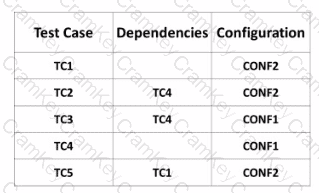| Exam Name: | ISTQB Certified Tester Foundation Level (CTFL v4.0) | ||
| Exam Code: | ISTQB-CTFL Dumps | ||
| Vendor: | ISTQB | Certification: | Foundation Level |
| Questions: | 406 Q&A's | Shared By: | ovie |
A Test Manager conducts risk assessment for a project. One of the identified risks is: The sub-contractor may fail to meet his commitment". If this risk materializes. it will lead to delay in completion of testing required for the current cycle.
Which of the following sentences correctly describes the risk?
For each test case to be executed, the following table specifies its dependencies and the required configuration of the test environment for running such test case:

Assume that C0NF1 is the initial configuration of the test environment Based on this assumption, which of the following is a test execution schedule that is compatible with the specified dependencies and allows minimising the number of switches between the different configurations of the test environment^
Which of the following statements refers to a good testing practice that applies to all software development lifecycles?
What is 'Component Testing'?